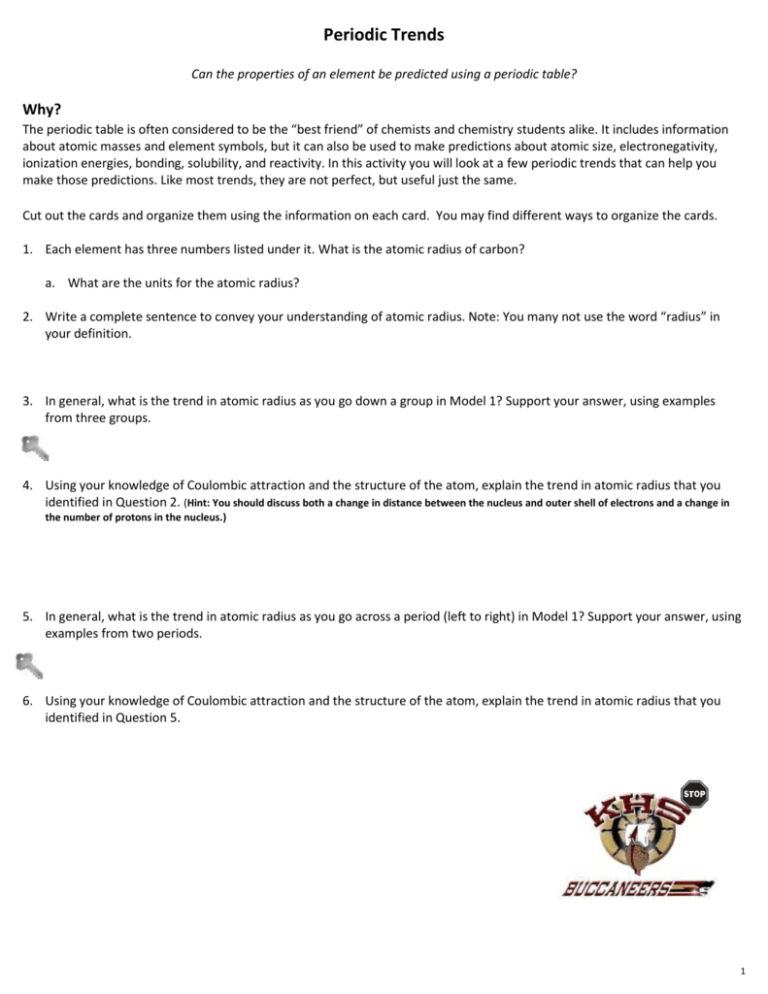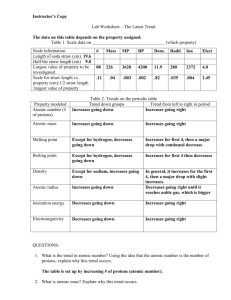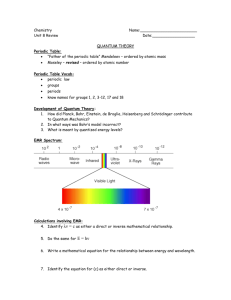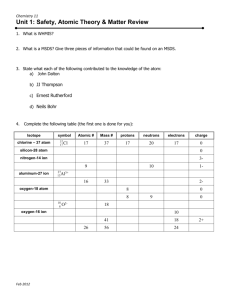Periodic Trends Worksheet: Atomic Radius, Electronegativity
advertisement

Periodic Trends Can the properties of an element be predicted using a periodic table? Why? The periodic table is often considered to be the “best friend” of chemists and chemistry students alike. It includes information about atomic masses and element symbols, but it can also be used to make predictions about atomic size, electronegativity, ionization energies, bonding, solubility, and reactivity. In this activity you will look at a few periodic trends that can help you make those predictions. Like most trends, they are not perfect, but useful just the same. Cut out the cards and organize them using the information on each card. You may find different ways to organize the cards. 1. Each element has three numbers listed under it. What is the atomic radius of carbon? a. What are the units for the atomic radius? 2. Write a complete sentence to convey your understanding of atomic radius. Note: You many not use the word “radius” in your definition. 3. In general, what is the trend in atomic radius as you go down a group in Model 1? Support your answer, using examples from three groups. 4. Using your knowledge of Coulombic attraction and the structure of the atom, explain the trend in atomic radius that you identified in Question 2. (Hint: You should discuss both a change in distance between the nucleus and outer shell of electrons and a change in the number of protons in the nucleus.) 5. In general, what is the trend in atomic radius as you go across a period (left to right) in Model 1? Support your answer, using examples from two periods. 6. Using your knowledge of Coulombic attraction and the structure of the atom, explain the trend in atomic radius that you identified in Question 5. 1 Read This! Electronegativity is a measure of the ability of an atom’s nucleus to attract electrons from a different atom within a chemical bond. A higher electronegativity value correlates to a stronger pull on the electrons in a bond. This value is only theoretical. It cannot be directly measured in the lab, but it does help us predict which how strongly atoms pull on the electrons of other atoms. 7. Using the definition stated in the Read This! box above, select the best visual representation for electronegativity. A B D C a. Explain why you chose the picture above. 8. Locate the electronegativity values in Model 1. What is the trend in electronegativity going down a group in Model 1? a. Explain the trend in electronegativities in terms of atomic structure and Coulombic attraction. A complete answer will address the change in the number of electron energy levels, the change in the number of protons, the strength of attraction between the nucleus and valence electrons, and the definition of electronegativity. 9. What is the trend in electronegativity going across a period in Model 1? 10. Explain the existence of the trend described in part c in terms of atomic structure and Coulombic attraction. A complete answer will address the change in the number of electron energy levels, the change in the number of protons, the strength of attraction between the nucleus and valence electrons, and the definition of electronegativity. 11. Rank the following elements from smallest to largest electronegativity based on the trends you have discovered thus far in the periodic table: barium (atomic number 56), bromine (atomic number 35), and iron (atomic number 26). Explain your reasoning. Smallest Largest Electronegativity _______ _______ _______ Electronegativity a. Explain your reasoning. 2 Read This! Ionization energy is the amount of energy that is required to remove a valence electron from an atom. If an atom has a large ionization energy this means that it is relatively hard to remove an electron from the atom, that is, it requires a lot of energy. 12. Locate the numbers in Model 1 that represent the ionization energy. Using your knowledge of Coulombic attraction, explain why ionization—removing an electron from an atom—takes energy. 13. Which should take more energy, removing an electron from an atom where the nucleus has a tight hold on its electrons, or a weak hold on its electrons? Explain. 14. In general, what is the trend in ionization energy as you go down a group? Support your answer using examples from three groups. 15. Using your knowledge of Coulombic attraction and the structure of the atom, explain the trend in ionization energy as you move down a group. A complete answer will address the change in the number of electron energy levels, the change in the number of protons, the strength of attraction between the nucleus and valence electrons, and the definition of electronegativity. 16. In general, what is the trend in ionization energy as you go left to right across a period? Support your answer using examples from two periods. 17. Using your knowledge of Coulombic attraction and the structure of the atom, explain the trend in ionization energy as you move from left to right across a period. A complete answer will address the change in the number of electron energy levels, the change in the number of protons, the strength of attraction between the nucleus and valence electrons, and the definition of electronegativity. 3 18. Atoms with loosely held electrons are usually classified as metals. They will exhibit high conductivity, ductility, and malleability because of their atomic structure. Would you expect metals to have high ionization energies or low ionization energies? Explain your answer in one to two complete sentences. 19. The diagrams below can summarize each of the three trends discussed in this activity. Use arrows to show the direction that each property increases both across the periods and the groups. For example, if a property gets weaker as you move down a group, you would draw the arrow pointing up. Ionization Energy Atomic Radius Strength of Attraction of Valence Electrons Electronegativity Reactivity 4 21. During this activity you may have noticed that not all of the data provided in the models followed the trends. Identify two places in Model 1 where the property listed does not fit the trend identified in this activity. 22. If every element doesn’t fit the trend, why is it still beneficial for chemists to understand as many periodic trends as they can? 23. Propose an explanation for one of the exceptions you identified in part a. Use your knowledge of atomic structure and Coulombic attraction in your hypothesis. 5








